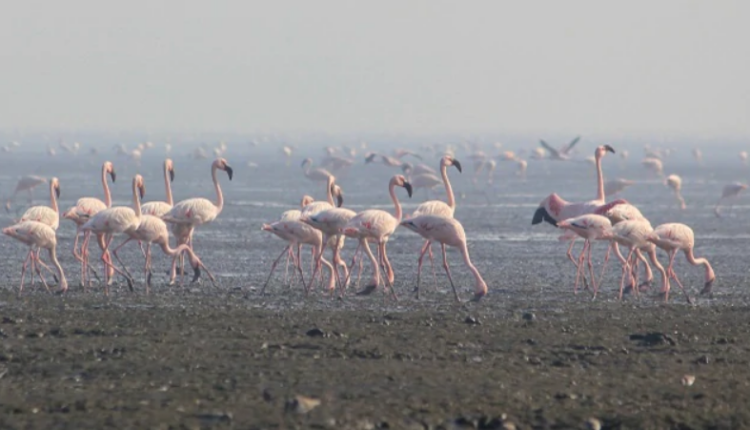
Bachi Karkaria’s Tales from TJ Road: What Sewri’s migratory flamingos have in common with their human counterparts
This story first appeared in Firstpost
Through this fortnightly column, Tales From TJ Road, Bachi Karkaria tells the story of Mumbai’s metromorphosis
***
Flamingoing, Going, Gone?
Last week I was asked to sign a petition addressed to our young, woke environment minister, Aditya Uddhav Thackeray. It was an appeal from the cheesily named Ministry of Mumbai’s Magic to save the city’s wrung-out wetlands, and thereby the flamingos. I happily added my signature. It wasn’t the usual NIMBY Factor but a YIMBY one: Yes (I want these massed beauties) In My Backyard. As wave upon wave of flamingos arrive between January and March, my neighbouring mudflats splash out in flamboyant rani-pink. This surreal sight elevates what snobby Bombay pronounces ‘Sewer-i’. The other bank of the Thane Creek near Navi Mumbai is their first port of call usually after September, when their home in the Rann of Kutch starts drying.
Rahul Khot, flamingo expert of the Bombay Natural History Society (BNHS), tells me that, while the odd bird was spotted during the Raj, the migration proper is recent. In 1994, the spectacle of 2,000 Greater and Lesser Flamingos had stunned an MbPT official, TV Sowrirajan. The discovery was duly hailed in the BNHS journal, Hornbill. In the last decade, Lesser Flamingos have accounted for 75 percent of the population. In 2019, there were 1,54,000 at peak season.
You know what? These migratory birds have much in common with their human counterparts. Not the shaming columns of pandemic-abandoned workers trudging their long, weary way back to their home states, but those who had arrived here bright-eyed with hope a century and more ago to make a better life for themselves. In the process they had made Bombay; contributing to its glory as much if not much more than the ‘sons of the soil’ so doughtily championed by Aditya’s grandfather. Most of these migrants had fueled the textile mills which spun gold for the city, earning it the crown of ‘urbs prima in indis’. And where were these mills concentrated? Right here in Parel, the hinterland of Sewri creek, seasonal home to the winged migrants.
Two, the early migrant workers had been driven to this mill-hub by the impoverishment of their Bihar/Uttar Pradesh villages; the migrant birds too had to fly west because of the depletion of their wetland homes in eastern India.
Three, the traders, craftsmen and entrepreneurs of 18th/19th century Bombay were originally from the hamlets of Gujarat; the Lesser Flamingo now migrates here from its home in the Rann of Kutch. The Greater Flamingo travels far greater distances from West Asia, Iran, Iraq, even South Africa
Four, just as human migrants came to Bombay to earn their daily bread, these wetlands are merely the flamingos’ feeding ground; both went/go home to breed. However, unlike the earlier mill-workers, the avian migrants bring their family of sub-adults back to the big city of better pickings.
Much before I came to live in Sewri, I would join the hundreds of flamingo-watchers flocking here at low tide, winding past the detritus of dockside industry, gingerly picking my way through the oil slicks and flotsam of plastic. These gorgeous birds determinedly returning to the increasing squalor became something of an article of faith, telling me that there must be something wondrous about this depressing part of the city that eluded us mortals, but was evident to the flamingo’s inner eye.
I have since dismissed that soppy bit of romanticism. I now know that organisms such as the blue-green algae — on which flamingoes feed — flourish in water with a high nitrogenous content, and the major source of that is untreated sewage. The death of the mills has forced its once-migrant workers into open-drain squalor, but that’s just the just the kind of pollution in which the avian migrants thrive. The lockdown has been party time thanks to the greater output of domestic sewage.
I had hoped to add one last comparison: that just as gentrification had drastically changed the migrant-centric mill hubs, progress aka the Sewri-Nhava Sheva Trans Harbour Link would impact this flamingo habitat. But Mr Khot plays spoiler. He insists, “More research is needed to conclude that the lights, clamour and vibrations of construction will have a negative impact. There were 40,000 birds just 100 metres from the bridge site. If there are fewer it could be that better rainfall in Kutch is keeping more of them at home there. Pollution is the main factor; the greater, the better for the flamingos’ food supply.”
Whatever works for them is fine by me. I told you in my introductory column that I live in a complex called Dosti Flamingos which, according to Friend Namita, ‘sounds like a Gay Nightclub’. To borrow the title of the recent, rah-rah-ed book of Friend Parmesh Shahani, I don’t want to lose my neighbouring splashy pink ‘Queeristan’ of the Sewri wetlands.
